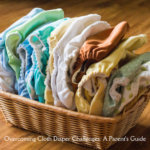Navigating the vast world of baby care products can be daunting, especially when it comes to ensuring comfort and dryness for your little one. Diaper inserts are a game-changer in this realm, providing enhanced absorbency and comfort for babies. This article explores the different types of diaper inserts, their uses, and provides brand recommendations to help you make the best choice for your child.
Understanding Diaper Inserts
What Are Diaper Inserts? Diaper inserts are layers of absorbent material used to boost the moisture-holding capacity of cloth diapers. They are essential for parents using cloth diapers who need extra protection, especially during the night or for heavy wetters.
Benefits of Using Diaper Inserts
- Increased Absorbency: Keeps your baby dry for longer periods.
- Adjustable Comfort: Allows for customization based on your baby’s needs.
- Economical: Reduces the frequency of diaper changes and extends the life of the diaper.

Types of Diaper Inserts
Materials and Absorbency
- Microfiber: Highly absorbent and quick-drying but should not touch the baby’s skin directly.
- Bamboo: Eco-friendly, soft, and with good absorbency, slower drying.
- Hemp: Extremely absorbent and durable, ideal for nighttime use but slower to dry.
- Cotton: A natural and gentle option, good absorbency, and easy to wash.
Shapes and Compatibility
- Rectangular Inserts: Universal fit for most diaper types.
- Hourglass Inserts: Cut to fit specific diaper brands with less bulk around the legs.
- Custom Shaped Inserts: Made specifically for certain brands or diaper styles.
How to Use Diaper Inserts
Insert Placement and Techniques
- In Pocket Diapers: Inserts are placed inside a pocket between the waterproof cover and the inner stay-dry liner.
- With Covers: Laid directly under the cover and over the liner if one is used.
- Doubling Up: Using two inserts for additional absorbency, often needed for nighttime or for older babies.
Tips for Optimal Use
- Pre-Wash: Always pre-wash new inserts to improve absorbency.
- Proper Positioning: Ensure the insert is flat and covers the required area to prevent leaks.

Brand Recommendations & What to look for
Absorbency Level: Match the insert to your baby’s typical output and the time of day.
Material Sensitivity: Choose hypoallergenic and natural fibers for sensitive skin.
Ease of Cleaning: Consider how easy it is to clean and dry the inserts, as this will impact your daily routine.
Practical Tips from a Dad of Three
Real-Life Application and Advice
- Routine Integration: Incorporate insert usage into your daily diaper routine to prevent disruptions.
- Storage Solutions: Keep inserts organized and accessible in your changing area to streamline changes.
- Wash Routine Optimization: Develop a wash routine that keeps your inserts in top condition without extra effort.
Making the Right Choice for Your Family
Choosing the right diaper inserts involves understanding the different types available, how they fit into your baby care routine, and what brands offer the best quality and value. By considering the types of inserts and their specific uses, you can enhance your baby’s comfort and keep them dry, all while managing an efficient and eco-friendly diapering system.
This comprehensive guide aims to demystify diaper inserts and provide you with the knowledge to choose the best options for your baby, ensuring that diapering is a smooth and comfortable experience for both you and your little one.







